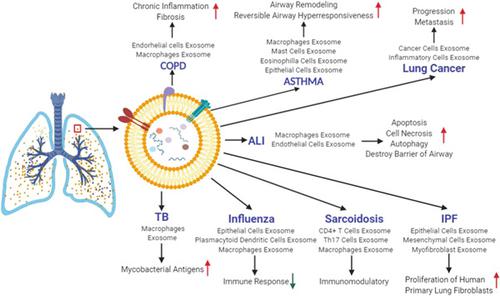当前位置:
X-MOL 学术
›
J. Cell. Physiol.
›
论文详情
Our official English website, www.x-mol.net, welcomes your
feedback! (Note: you will need to create a separate account there.)
The role of exosomes from BALF in lung disease
Journal of Cellular Physiology ( IF 4.5 ) Pub Date : 2021-08-13 , DOI: 10.1002/jcp.30553 Ziyu Liu 1, 2 , Jiaqing Yan 3 , Lingling Tong 4 , Shouyue Liu 5 , Ying Zhang 1
Journal of Cellular Physiology ( IF 4.5 ) Pub Date : 2021-08-13 , DOI: 10.1002/jcp.30553 Ziyu Liu 1, 2 , Jiaqing Yan 3 , Lingling Tong 4 , Shouyue Liu 5 , Ying Zhang 1
Affiliation

|
Exosomes are released from a variety of immune cells and nonimmune cells, the phospholipid vesicle bilayer membrane structure actively secreted into tissues. Recently, exosomes were demonstrated to be effectively delivered proteins, cholesterol, lipids, and amounts of DNA, mRNA, and noncoding RNAs to a target cell or tissue from a host cell. These can be detected in blood, urine, exhaled breath condensates, bronchoalveolar lavage fluid (BALF), ascites, and cerebrospinal fluid. BALF is a clinical examination method for obtaining alveolar cells and biochemical components, reflecting changes in the lungs, so it is also called liquid biopsy. Exosomes from BALF become a new method for intercellular communication and well-documented in various pulmonary diseases. In chronic obstructive pulmonary disease (COPD), BALF exosomes can predict the degree of COPD damage and serve as an effective monitoring indicator for airflow limitation and airway remodeling. It also mediates antigen presentation in the airways to the adaptive immune system as well as costimulatory effects. Furthermore, BALF exosomes from acute lung injury and infective diseases are closely related to various infections and lack of oxygen status. BALF exosomes play an important role in the diagnosis and prognosis of lung cancer. The effect of immunomodulatory role for BALF exosomes in adaptive and innate immune responses has been studied in sarcoidosis. The intercellular communication in the microenvironment of BALF exosomes in pulmonary fibrosis and lung remodeling have been studied. In this review, we summarize the novel findings of exosomes in BALF, executed function by protein, miRNA, DNA cytokine, and so on in several pulmonary diseases.
中文翻译:

来自 BALF 的外泌体在肺病中的作用
外泌体是从多种免疫细胞和非免疫细胞中释放出来的,磷脂囊泡双层膜结构主动分泌到组织中。最近,外泌体被证明可以有效地将蛋白质、胆固醇、脂质和大量的 DNA、mRNA 和非编码 RNA 从宿主细胞传递到靶细胞或组织。这些可以在血液、尿液、呼出气冷凝液、支气管肺泡灌洗液 (BALF)、腹水和脑脊液中检测到。BALF是临床上获取肺泡细胞和生化成分,反映肺部变化的检查方法,故又称液体活检。来自 BALF 的外泌体成为一种新的细胞间通讯方法,并在各种肺部疾病中得到充分证明。在慢性阻塞性肺病(COPD)中,BALF外泌体可以预测COPD损伤程度,作为气流受限和气道重塑的有效监测指标。它还介导气道中的抗原呈递到适应性免疫系统以及共刺激作用。此外,急性肺损伤和感染性疾病的 BALF 外泌体与各种感染和缺氧状态密切相关。BALF外泌体在肺癌的诊断和预后中发挥重要作用。已在结节病中研究了 BALF 外泌体在适应性和先天免疫反应中的免疫调节作用。已经研究了肺纤维化和肺重塑中 BALF 外泌体微环境中的细胞间通讯。在这篇综述中,我们总结了 BALF 中外泌体的新发现,通过蛋白质、miRNA、
更新日期:2021-08-13
中文翻译:

来自 BALF 的外泌体在肺病中的作用
外泌体是从多种免疫细胞和非免疫细胞中释放出来的,磷脂囊泡双层膜结构主动分泌到组织中。最近,外泌体被证明可以有效地将蛋白质、胆固醇、脂质和大量的 DNA、mRNA 和非编码 RNA 从宿主细胞传递到靶细胞或组织。这些可以在血液、尿液、呼出气冷凝液、支气管肺泡灌洗液 (BALF)、腹水和脑脊液中检测到。BALF是临床上获取肺泡细胞和生化成分,反映肺部变化的检查方法,故又称液体活检。来自 BALF 的外泌体成为一种新的细胞间通讯方法,并在各种肺部疾病中得到充分证明。在慢性阻塞性肺病(COPD)中,BALF外泌体可以预测COPD损伤程度,作为气流受限和气道重塑的有效监测指标。它还介导气道中的抗原呈递到适应性免疫系统以及共刺激作用。此外,急性肺损伤和感染性疾病的 BALF 外泌体与各种感染和缺氧状态密切相关。BALF外泌体在肺癌的诊断和预后中发挥重要作用。已在结节病中研究了 BALF 外泌体在适应性和先天免疫反应中的免疫调节作用。已经研究了肺纤维化和肺重塑中 BALF 外泌体微环境中的细胞间通讯。在这篇综述中,我们总结了 BALF 中外泌体的新发现,通过蛋白质、miRNA、











































 京公网安备 11010802027423号
京公网安备 11010802027423号